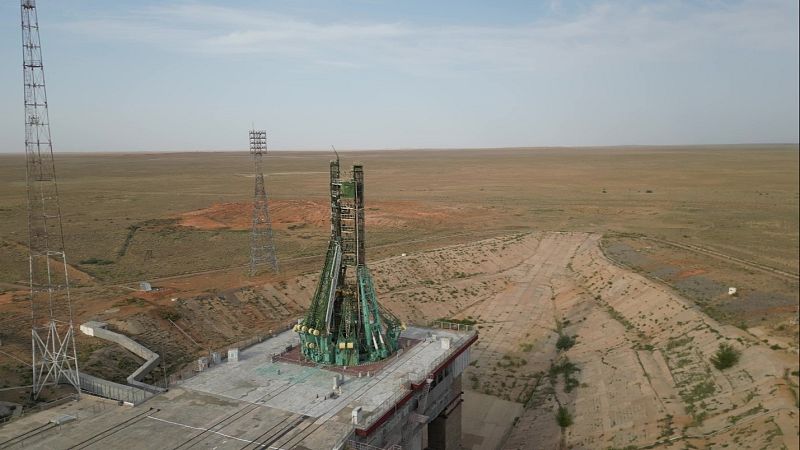Baikonur Cosmodrome: A New Era of Space Tourism
Baikonur Cosmodrome, a historic site that has long been central to space exploration, is undergoing a significant transformation. While Russia continues to lease the facility, it has already returned over fifty decommissioned structures to Kazakhstan. These facilities are now being considered for development into a vibrant tourism ecosystem, one that will attract visitors year-round and not just during rocket launches.
The initiative aims to leverage the rich history of the site, particularly the iconic Gagarin’s launchpad. This location marks the spot where Yuri Gagarin made history in 1961 as the first human to travel into space aboard Vostok 1. The government is planning to create immersive experiences around this landmark, including hotels, glamping areas, and a children’s camp. These developments will allow tourists to engage with the legacy of space exploration in a more interactive way.
The national aerospace committee company has taken on the responsibility of managing the launchpad, overseeing funding, maintenance, and general operations. This move is a crucial step in preparing the site for tourism. Russia officially transferred the site to Kazakhstan in June, marking a new chapter in the relationship between the two countries.
A Vision for the Future
The tourism concept for Baikonur is set to be approved in September, with the first step involving inspections of decommissioned facilities to ensure they meet safety standards. As part of the plan, iconic sites will be reconstructed as part of an open-air museum. This includes Gagarin’s launchpad and the Assembly and Fueling Complex, which once played a vital role in preparing the Energia rocket and Buran shuttle.
Infrastructure development is also a key component of the plan. Essential facilities such as hotels, glamping areas, visitor centers with retail zones, restaurants, and a children’s camp are all part of the vision. The goal is to create a comprehensive experience that allows visitors to explore the history of space exploration while enjoying modern comforts.
Inspiration Through Space
Space tourism is seen as a powerful source of inspiration, especially for younger generations. “Space is, above all, a dream for humanity — a dream to explore galaxies and discover new planets,” says the Chairman of the Aerospace Committee, Baubek Oralmagambetov. He emphasizes that this kind of tourism helps children learn about space exploration and motivates them to pursue their goals.
One unique aspect of the experience is the opportunity to witness rocket launches from a yurt. Last year, Kazakhstan installed a metal-structured yurt at a viewing platform near Baikonur’s 31st launch pad, offering tourists a chance to watch rocket launches up close. So far this year, visitors have witnessed three launches, with three more scheduled before December.
Expanding Visitor Numbers
Authorities estimate that with expanded lodgings, Baikonur could welcome up to 50,000 visitors a year by 2029—a fivefold increase from current figures. This growth is part of a broader strategy to develop four main areas of ground-based space tourism: educational tours, cultural and discovery-based tours, event-driven tourism, and adventure and active tours.
MICE (Meetings, Incentives, Conferences, and Exhibitions) tourism is also seen as a potential area for growth. Leila Bakytova, Chief Manager of the Management Board Chairman’s Office at Kazakh Tourism, highlights the exciting event formats that could be brought to the region.
Interactive Experiences
Experts believe the potential for interactive exhibits and hands-on simulations is just beginning to be explored. “It would be amazing if people could witness a rocket launch with their own eyes—feeling like Korolev himself giving the command to launch,” explains museum expert Rinat Kutdussov. Thanks to new technologies, visitors could simulate the experience of launching a rocket from the control center, even if it’s on screens or in virtual form.
The idea is to make visitors feel like part of the crew, immersing them in the soundscape and multimedia effects that accompany space missions. This approach aims to create a deeper connection between visitors and the legacy of space exploration.
Aligning with Space Ambitions
Baikonur’s growing tourism ambitions align with Kazakhstan’s broader space strategy. One of its key goals is to commercialize Soyuz rocket launches by 2028 using upgraded local infrastructure, as part of the Russian-Kazakh Baiterek project. The first test flight is planned for the end of this year, followed by additional test launches in 2026 and 2027, with commercialization set for 2028.
Prime Minister Olzhas Bektenov has confirmed that construction of the Baiterek Space Rocket Complex and development of the Soyuz-5 rocket remain on schedule. According to Roscosmos, the rocket will launch from Baikonur in December this year.
For now, rocket launches remain Baikonur’s main tourist attraction. Officials say the transformation is only beginning—but it’s designed to inspire everyone, from curious schoolchildren to lifelong space enthusiasts.
